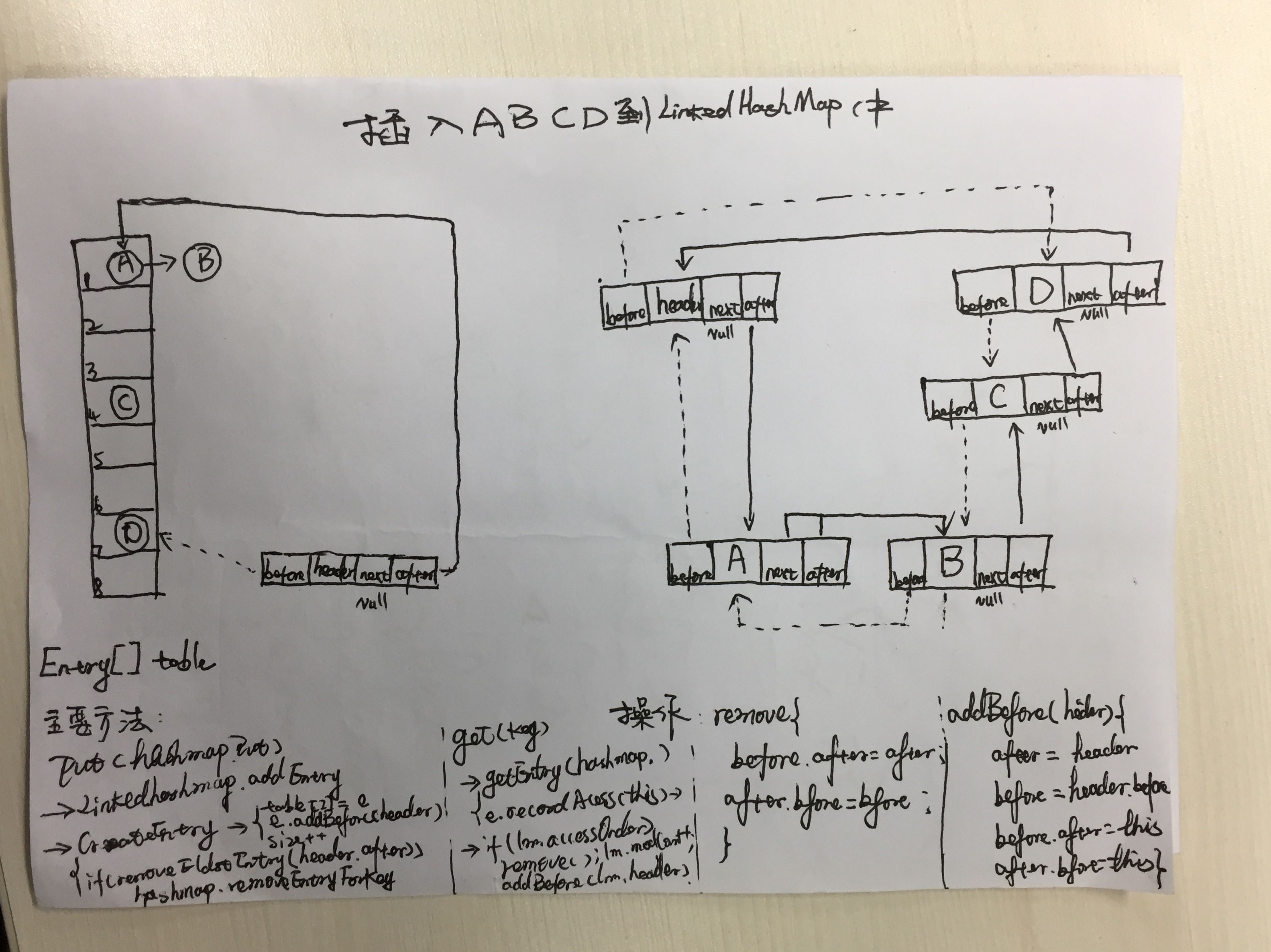LinkedHashMap结构get和put源码流程简析及LRU应用
原理这篇讲得比较透彻Java集合之LinkedHashMap。
本文属于源码阅读笔记,因put,get调用逻辑及链表维护逻辑复杂(至少网上其它文章的逻辑描述及配图,我都没看明白LinkedHashMap到底长啥样),所以以文字描述和手画逻辑图的方式来讲述源码逻辑,阅读时再辅以源码达到事半功倍的效果。
1.LinkedHashMap简要介绍。
LinkedHashMap继承hashMap,并维护一个双向链表保持有序(与haspmasp最重要的区别),accessOrder==true初始化时按访问顺序输出,默认按插入顺序输出,如下图所示,左边为Entry数组实现的hashtable存储结构,右边为双向链表结构,header为链表头,A离header最近可通过header.after访问, D离header最远为队尾,可通过header.before来访问,LRU删除最近最少使用时指的是A即header.after,新插入或者被访问(accessOrder为true)时先存储到左侧的hashtable中并将链表位置移动到D后面。左下方为put和get调用流程,右下为Entry中操作链表的方法remove,addBefore源码。

2.put及get和remove流程
put流程:HashMap.put(Object key)-->LinkedHashMap.addEntry(hash, key, value, i)(要么重写removeEldestEntry可删除元素达到维持固定长度,要么扩容判断(size>=threshold时扩容))-->LinkedHashMap.createEntry(hash, key, value, bucketIndex)将Entry存储到tabel[Index]-->LinkedHashMap.中e.addBefore(header)将当前元素加到header的before,即链表队尾.
get流程:LinkedHashMap.get(key)-->HashMap.getEntry(key);get同时并记录访问LinkedHashMap中e.recordAccess(this)-->如果accessOrder==true,则调用LinkedHashMap.Entry.remove从链表this中删除e自己,LinkedHashMap.Entry.addBefore(header)把自己加入链表队尾,保持最远(离header最远,在队尾)最新。
remove流程:三种情况,一种为put时限制容量(重写removeEldestEntry)删除,HashMap.put-->LinkedHashMap.addEntry-->HashMap.removeEntryForKey(从hashTable中删除元素)-->LinkedHashMap.e.recordRemoval(this)-->LinkedHashMap.Entry.remove(将自己从链表删除中);第二种直接remove, HashMap.remove(object key)-->HashMap.removeEntryForKey后续与第一种情况相同。第三种,遍历器中删除,for(Iterator iterator=lru1.keySet().iterator();iterator.hasNext();) {iterator=iterator.next;iterator.remove();},HashMap.KeySet().iterator().newKeyIterator().KeyIterator().HashIterator().remove()-->HashMap.this.removeEntryForKey(current.key)后续与第一种情况相同。
说明:LinkedHashMap.Entry中remove及addBefore操作中的before,after,此二指针为Entry所有,当通过e.addBefore(header)调用时,before及after指的是当前调用实体Entry e的before,after指针,切勿以为是LinkedHashMap的成员,本人就是在找此二公初始化的地方时困惑了两天。header为LinkedHashMap私有属性,在LinkedHashMap.init()进行初始化并且不会被改变。
内部存储直接继承hashpMap,代码在hashpmap中,Entry[] table即hashtable来存,如上图左边,
public class HashMap<K,V>
extends AbstractMap<K,V>
implements Map<K,V>, Cloneable, Serializable
{ transient Entry[] table;
static class Entry<K,V> implements Map.Entry<K,V> {
final K key;
V value;
Entry<K,V> next;
final int hash; /**
* Creates new entry.
*/
Entry(int h, K k, V v, Entry<K,V> n) {
value = v;
next = n;
key = k;
hash = h;
}
}
}
LinkedHashMap中对Entry进行继承并增加两个元素,before,after
public class LinkedHashMap<K,V>
extends HashMap<K,V>
implements Map<K,V>
{
//链表头
//初始化流程LinkedHashMap()-->super(initialCapacity, loadFactor)-->HashMap.HashMap()-->LinkedHashMap.init()
//-->header = new Entry<K,V>(-1, null, null, null);header.before = header.after = header;
private transient Entry<K,V> header;//header.hash=-1
//添加元素时,调用HashMap.put(Object key)-->LinkedHashMap.addEntry(hash, key, value, i)
void addEntry(int hash, K key, V value, int bucketIndex) {
createEntry(hash, key, value, bucketIndex);
// Remove eldest entry if instructed, else grow capacity if appropriate
Entry<K,V> eldest = header.after;
if (removeEldestEntry(eldest)) { //size>cachesize时删除最近最少使用元素
removeEntryForKey(eldest.key);
} else {
if (size >= threshold)
resize(2 * table.length);//扩容
}
}
private static class Entry<K,V> extends HashMap.Entry<K,V> {
// These fields comprise the doubly linked list used for iteration.
Entry<K,V> before, after;
Entry(int hash, K key, V value, HashMap.Entry<K,V> next) {
super(hash, key, value, next);
}
/**
* Removes this entry from the linked list.
*/
private void remove() {
before.after = after;
after.before = before;
}
/**
* Inserts this entry before the specified existing entry in the list.
*/
private void addBefore(Entry<K,V> existingEntry) {
after = existingEntry;
before = existingEntry.before;
before.after = this;
after.before = this;
}
/**
* This method is invoked by the superclass whenever the value
* of a pre-existing entry is read by Map.get or modified by Map.set.
* If the enclosing Map is access-ordered, it moves the entry
* to the end of the list; otherwise, it does nothing.
*/
void recordAccess(HashMap<K,V> m) {
LinkedHashMap<K,V> lm = (LinkedHashMap<K,V>)m;
if (lm.accessOrder) {
lm.modCount++;
remove();
addBefore(lm.header);
}
}
void recordRemoval(HashMap<K,V> m) {
remove();
}
}
}
3.LRU cache应用
Least Recently Used最近最少算法,重写removeEldestEntry方法并在初始化时传入accessOrder==true,实现cache,保持固定长度,并删除最近(离header最近,即header.after元素)最少(新加入或者被访问时都加到队尾header.before,最旧即最少访问的元素离header最近)使用的元素。
LinkedHashMap特别有意思,它不仅仅是在HashMap上增加Entry的双向链接,它更能借助此特性实现保证Iterator迭代按照插入顺序(以insert模式创建LinkedHashMap)或者实现LRU(Least Recently Used最近最少算法,以access模式创建LinkedHashMap)。
更多实现方式LRU缓存实现(Java),线程安全LRU缓存参考ConcurrentLinkedHashMap设计与代码解析
package hashmap_thread; import java.util.Collections;
import java.util.LinkedHashMap;
import java.util.Map; /**
* @author pujiahong2006@163.com</br> Created By: 2018-12-17 下午6:22:17
*/
public class LRU_cache {
//cache大小
final static int cacheSize = 4;
//初始化LinkedHashMap,并传入参数accessOrder为true
//内部Entry[] table的长度capacity为2的N次方,且 capacity<initCapacity,此处initCapacity若为(cacheSize /0.75f) + 1时,
//扩容阈值threshold最大能等于cachesize,当size等于cachesize时会触发扩容,因此需扩大threshold,需扩大capacity,而扩大capacity必须是2的N次方,
//即最小(N为1)要扩大两倍,initCapacity需扩大两倍,经测算initCapacity=((cacheSize*2) /0.75f) + 1时能保证不扩容,
//但浪费空间太大,以cachesize=48来算,initCapacity=129,capacity=128,threshold=capacity*loadfactor=96,loadfactor=0.75f
//此处已重写removeEldestEntry,LinkedHashMap.addEntry时size<=48时,size<threshold=96没有触发扩容限值
//扩容就变为一个函数求解,threshold>cachesize时就不扩容,threshold=capacity*loadfactor,capacity=power(2,N)<initCapacity,
//initCapacity=Z*cacheSize+1,求解Z,最终Z=2/loadFactor
static Map lru1 = new LinkedHashMap<String, String>((int) Math.ceil((cacheSize*2) / 0.75f) + 1,
0.75f, true) {
@Override
//重写removeEldestEntry,维持默写size,超过时删除最近最少使用
protected boolean removeEldestEntry(Map.Entry<String, String> eldest) {
return size() > cacheSize;
}
}; public void synchMap() {
lru1 = Collections.synchronizedMap(lru1); } public static void main(String[] args) {
lru1.put("11", "aa");
lru1.put("33", "cc");
lru1.put("00", "dd");
lru1.put("22", "hh");
lru1.put("66", "kk");//超过容量4的限制,删除近最少使用header.after元素11 lru1.get("00");//本来00排在33后,22前,但被访问后,移动到队尾header.before,即最远最新元素。 System.out.println(lru1); }
} 输出:
{33=cc, 22=hh, 66=kk, 00=dd}
LinkedHashMap结构get和put源码流程简析及LRU应用的更多相关文章
- .Net Framework4.5.2 源码命名空间简析
Miscosoft目前除.Net Core开源外,对于.Net4.5.1 , 4.5.2等后续版本同样开源.资源中包含sln,csproj等以方便我们在vs中打开它们,不过我们不能编译它,因为它缺少r ...
- 【原创】Ingress-Nginx-Controller的Metrics监控源码改造简析
一.背景 目前我们的生产环境一层Nginx已经容器化部署,但是监控并不完善,我们期望其具有Ingress-Nginx-Controller组件上报监控的数据.这样可以建立请求全链路的监控大盘.有利于监 ...
- Flask 源码流程,上下文管理
源码流程 创建对象 from flask import Flask """ 1 实例化对象 app """ app = Flask(__na ...
- ES6.3.2 index操作源码流程
ES 6.3.2 index 操作源码流程 client 发送请求 TransportBulkAction#doExecute(Task,BulkRequest,listener) 解析请求,是否要自 ...
- Eureka服务端源码流程梳理
一.简述 spring cloud三步走,一导包,二依赖,三配置为我们简化了太多东西,以至于很多东西知其然不知其所以然,了解底层实现之后对于一些问题我们也可以快速的定位问题所在. spring clo ...
- django-admin的源码流程
一.admin的源码流程 首先可以确定的是:路由关系一定对应一个视图函数 a.当点击运行的时候,会先找到每一个app中的admin.py文件,并执行 b.执行urls.py admin.site是什么 ...
- Django session 源码流程
流程 Django session源码流程 首先执行的是SessionMiddleware的init方法 import_module(settings.SESSION_ENGINE) 导入了一个 dj ...
- rest_framework解析器组件源码流程
rest_framework解析器组件源码流程 解析器顾名思义就是对请求体进行解析.为什么要有解析器?原因很简单,当后台和前端进行交互的时候数据类型不一定都是表单数据或者json,当然也有其他类型的数 ...
- 【转】ANDROID自定义视图——onMeasure,MeasureSpec源码 流程 思路详解
原文地址:http://blog.csdn.net/a396901990/article/details/36475213 简介: 在自定义view的时候,其实很简单,只需要知道3步骤: 1.测量—— ...
随机推荐
- [蓝桥杯]ALGO-51.算法训练_Torry的困惑(基本型)
题目描述: 问题描述 Torry从小喜爱数学.一天,老师告诉他,像2...……这样的数叫做质数.Torry突然想到一个问题,前10...……个质数的乘积是多少呢?他把这个问题告诉老师.老师愣住了,一时 ...
- Hadoop 管理工具HUE配置-Yarn Resource Manager HA配置
安装HUE之后,需要配置很多东西才能将这个系统的功能发挥出来,因为Yarn是配置的HA模式,所以在配置HUE的时候,会有些不用,下面一段文字是官网拿来的 # Configuration for YAR ...
- 知识点-jar包
JAR文件的全称是Java Archive File,意思就是Java档案文件.通常JAR文件是一种压缩文件,与常见的ZIP压缩文件兼容,同城也被称为JAR包.JAR文件与zip文件的去区别就是在JA ...
- java高并发编程(五)线程池
摘自马士兵java并发编程 一.认识Executor.ExecutorService.Callable.Executors /** * 认识Executor */ package yxxy.c_026 ...
- 峰Redis学习(7)Redis 之Keys 通用操作
keys * 显示所有key 查找所有以s开头的key 用s* *代表任意字符 127.0.0.1:6379> keys s* 1) "set3" 2) "s ...
- folly无锁队列正确性说明
folly无锁队列是facebook开源的一个无所队列,使用的是单向链表,通过compare_exchange语句实现的多生产多消费的队列,我曾经花了比较多的时间学习memory_order的说明,对 ...
- JVM -verbose参数详解(转)
原文 http://www.javaranger.com/archives/367 java -verbose[:class|gc|jni] 在输出设备上显示虚拟机运行信息. java -verbos ...
- C++单例模式的实现及举例
单例模式的概念和用途: 在它的核心结构中只包含一个被称为单例的特殊类.通过单例模式可以保证系统中一个类只有一个实例而且该实例易于外界访问,从而方便实例个数的控制并节约系统资源. 如果希望在系统中某个类 ...
- VLAN 及 GVRP 配置
一.VLAN配置 +进入vlan视图,如果指定的vlan没有创建则先创建它 [undo]vlan vlan_id undo vlan 剔除已创建的vlan VLAN_id:要进入的或要创建并进入的VL ...
- [UE4]函数和事件的区别
一.函数有返回值,事件无返回值 二.函数调用会等待函数执行结果,事件调用只是触发但不会等待. 三.函数执行在同一个线程,事件执行在不同线程. 四.函数可以用局部变量,事件没有局部变量. 五.因为函数执 ...
